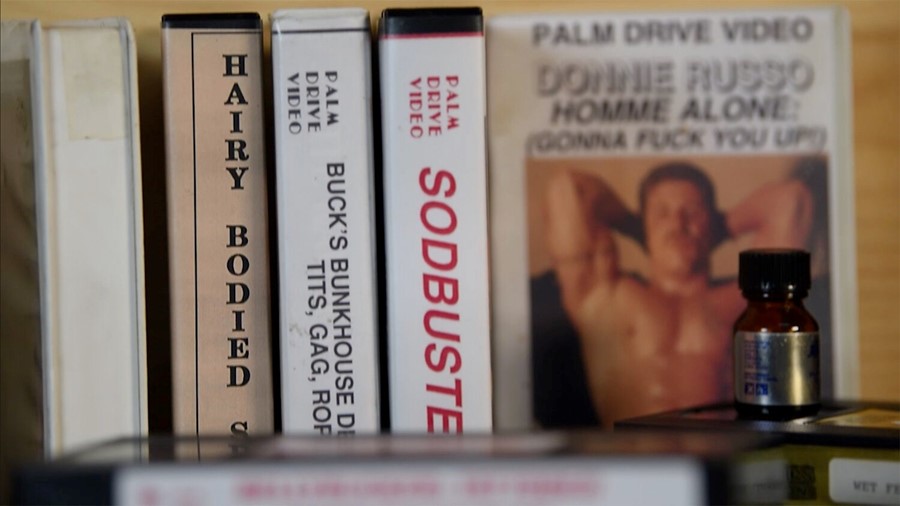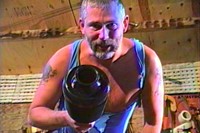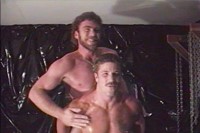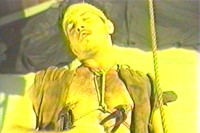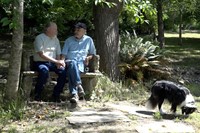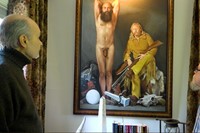Legendary leatherman Jack Fritscher shares his tales of editing BDSM and leather publication Drummer, his relationship with Robert Mapplethorpe, and the new documentary about his production company Palm Drive Video
Jack Fritscher is legendary in San Francisco’s leather, fetish and BDSM community. His story is set in SoMa, to the north-east of the city – before tech companies came in like virtual bulldozers, gentrifying the area into another Silicon Valley. So much unacknowledged history occurred in this 13-block area between 1970 and 2000, and I’m convinced that these stories will one day be recognised as among the most interesting cultural milestones of the 21st century.
Fritscher was the founding editor of the granddaddy of all BDSM and leather publications, Drummer magazine, and gave an unknown photographer, Robert Mapplethorpe, his first published cover. Together with his longtime partner, Mark Hemry, they created Palm Drive Video, the most notorious kink and fetish production company of the 1980s.
Now, a feature-length documentary titled Raw! Uncut! Video!: A Love Story About Fetish Porn has been created by directors Ryan A White and Alex Clausen to finally tell this story. They say if you live long enough, you finally receive just rewards. For Fritscher, that’s long overdue.
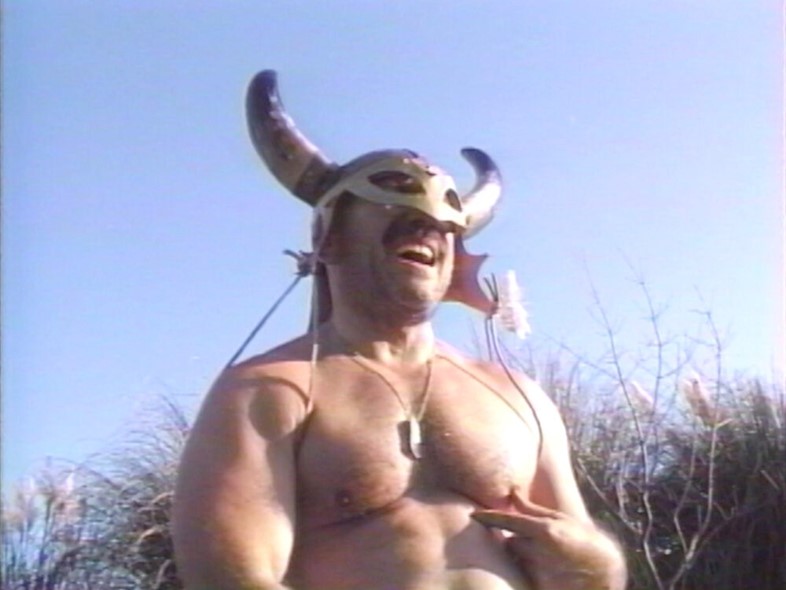
Rick Castro: Do you remember how you and I first connected?
Jack Fritscher: How did we meet? Were you all in black? Or wearing hustler white? Before you and I met, your art met me in your 1991 book Castro. When I was interviewing British critic Edward-Lucie Smith in 1992 for my memoir of my affair with Robert Mapplethorpe, he mentioned you as a young talent to watch, as did photographer Joel-Peter Witkin whom I also interviewed.
You and I finally met in person on 10 June 2017, when Ryan White and Alex Clausen brought you to my home to interview me for Raw! Uncut! Video: A Fetish Love Story. From the moment you exited the car in the driveway of my farmless farmhouse, I felt bonded artist to artist, person to person. Having followed your career for 30 years at a distance, I knew I could trust you as an artist to ask the right questions.
RC: What was your personal introduction to BDSM?
JF: My attraction to BDSM was counter-phobic. I eroticised what scared me. People naturally do that. The violence of the second world war became insanely surreal with the kind of terror that can only be survived by making it erotic. I was six, going on seven, when the war ended and my little head was spinning with images of sweet neighbourhood boys, older playmates, who came home from the war as grown-up men in uniform, hugging me into their sweet hot smells of wool and aftershave and tobacco. They would tell rugged tales of boot camp training and barracks horseplay that made me feel faint with a fear of hard men, which soon became a desire for hard men.
I have to thank the Catholic church for teaching us grade-school kids about young martyrs in ancient Rome who were humiliated in public bondage, like the 40 Roman legionnaires who were stripped naked by uniformed legionnaires and tied up to die exposed on a frozen lake for converting to Christianity. Religious S&M! If that makes you holy, makes you a saint, then leather bars must be heaven.
RC: What were you doing before Drummer magazine?
JF: I began editing Drummer when I was 37. Before that I was in graduate school, then writing, then doing social work, photography and super-8 filmmaking, and university teaching. I entered the all-male safety of the Pontifical College Josephinum where I studied to be a priest in the closet while working as an assistant editor on the national Josephinum Review newspaper, as well as a freelance book editor for a religious press in Maryland. During this time, I was a disruptive teenage-heretic rebel with a cause.
When my beloved JFK, my platonic ideal of a first lover, was murdered on November 22, 1963, I figured life was too short for a boy who was born a gay writer struggling to become a straight priest whose writing would always be censored. Two weeks later, after 11 years of study, I left the cloister of the seminary with a perfect medieval education in the classics, and entered graduate school in Chicago.
All my years of teenage, school sexual denial jet-fuelled my male-male athletic fantasies, which led me into actual S&M experiences I was beginning to write as erotic sex stories. I wanted to turn sex into art because art makes sense of life. In 1964, I began teaching at Loyola University in Chicago where I wrote my first novel, What They Did to the Kid: Confessions of an Altar Boy, while I earned my doctorate in 1967 with my dissertation on Tennessee Williams who, by the way, has written some of the best gay S&M kink stories.
While there, I came out among the leathermen at the Gold Coast bar and met Chuck Renslow and Dom Orejudos, AKA Etienne. One night in 1965, I went with them to Illinois Institute of Technology which was screening Kenneth Anger’s Scorpio Rising, the iconic 1964 movie that changed my life because it showed how leather S&M sex could be made into art.
I first arrived in San Francisco in 1961, went directly to City Lights Bookstore looking for beatnik poets, and found instead a treasure trove of little beefcake porn magazines like Tomorrow’s Man. I was born in the Midwest but was reborn in San Francisco while I was a commuter and sex tourist in the 1960s, until I moved to the city in 1970 and broke totally free of the closet. I posed for S&M photos with my lover David Sparrow for Whipcrack magazine shot by Walt Jebe, who owned Jebe’s Camera and Photo Shop at 19th Street and Castro. During the psychedelic 1960s, the ever-jolly Jebe dared to print gay photographs no one else would develop. Unfortunately, when New Yorkers began colonising San Francisco, Jebe’s Photo was the competition Harvey Milk drove out of business when he opened his Castro Camera shop around the corner, 100 feet away, in 1972.
RC: I’ve always called Drummer the granddaddy of all leather publications. Please tell me about its creation and how it all came about.
JF: The “Drummer Origin Story” is its own kind of quicksand. Legend versus truth. Drummer was founded by John Embry, and born as a bar rag in Los Angeles in 1971, with ads for toupees and the Bla Bla Café. In 1972, Drummer merged with Larry Townsend’s activist newsletter for the HELP Foundation (Homophile Effort for Legal Protection) which bailed out men entrapped by the LAPD. But by 1973, Townsend was fed up with Embry’s toxic business practices.
On 20 June 1975, Embry published the [larger] Time magazine-size Drummer, which everyone now thinks of as the first issue. After baiting the LAPD by publishing forbidden content about teen sex, race fetishes, Embry – along with the Drummer staff, and 40 guests – was arrested by the LAPD at the infamous “Drummer Slave Auction” on 10 April 1976. That was when Police Chief Ed Davis effectively cancelled Drummer in LA, and drove it out of town.
Drummer had published only 12 issues and quickly fled LA to liberation in San Francisco, where Embry asked me to become the “founding San Francisco editor.” I worked to change the Drummer leather focus to a free-wheeling homomasculinity which widened our subscription base beyond the leather fetish to all kinds of kink. Drummer created a living, breathing leather fraternity by presenting men across the US with masculine images of themselves rather than the “Blueboy” stereotypes presented in mainstream media. Their exotic Personal Ads webbed men together as the Grindr of its day.

RC: What was the response?
JF: Like the Procol Harum song A Whiter Shade of Pale, the “crowd called out for more.” Subscriptions shot up. We dropped the Bla Bla toupees and turned Drummer into a leather-identity magazine of homomasculinity.
I asked, begged the readers, back in the day when leather was so closeted that cameras were verboten, to send their photos and stories in for publication in my new “Tough Customers” column. My intent was to reflect the readers to themselves in prose and pictures because they could give a better representative take on leather than faux-leather porn models. A popular saying at the time said, “Lips that touch Naugahyde will never touch mine.” As a result, Drummer – which ran over 24 years and 219 issues – is a fabulous document of the authentic way we were when leather life was inventing itself nightly. It was valued by writers and artists and photographers who liked its sophisticated approach to legitimising erotic art.
RC: Who were some of your featured artists, photographers and writers?
JF: We published well over 100 established and emerging graphic artists. Our art director, who was the art doyen who invited them into Drummer, was the under-sung and fabulous artist, A Jay (Al Shapiro), who had been founding 1960s art director for Queens Quarterly where he launched his cartoon strip “Harry Chess” which he brought with him to Drummer.
Al, who had moved from Brooklyn to San Francisco and had worked with Jim French AKA Luger at Colt Studio, knew everybody who was anybody. He was key to all the artists he invited into our pages, like Bill Ward, Harry Bush, Bishop and Roy Dean. Al was a lovely cultured man who loved jockstraps and water sports. He died of Aids in 1988. He and I, through text and illustrations, invited a mix of old and new talents like Robert Mapplethorpe, Tom of Finland, Etienne (Dom Orejudos), Oscar-Streaker Robert Opel, Sam Steward aka Phil Andros, LA surfer artist Skipper, Domino, and the Hun (Bill Schmeling).
RC: Tell me about your relationship with Robert Mapplethorpe, and how you came to publish his first cover.
JF: When Robert Mapplethorpe was a young unknown who couldn’t get arrested, he flew to my desk at Drummer in 1977 and showed his portfolio because he wanted to reach kinky new leather models and rich photography collectors. I assigned him to shoot the cover of Drummer 24. At the same time, I reviewed his portfolio – his first review in the gay press – in my special extra edition of Drummer, “Son of Drummer,” September 1978.
Our lovely mad affair lasted almost three polyamorous years from Halloween 1977 to spring 1980. Our friendship lasted until his death in 1989. He was the dearest, sweetest man who was demonised by Republican politicians who censored his art and denounced him on the floor of the US Senate in 1989. Robert was an artist who was a photographer who knew how to turn sex into art. Robert liked to fuck writers because he wanted to be a story told in beds at night around the world. So at his request I began writing about him, teaching approaches to his work, and defending him in 1978. I loved him. He loved me. I still love him. While he was alive, I got his seed. When he died, Patti Smith got his ashes.
RC: Did the magazine remain “cult” or eventually crossover into the mainstream? (Whatever that is.)
JF: Drummer began as a cult magazine dedicated to men who prefer men masculine. In fact, it was kind of double-cult. It was gay. It was masculine. It gave masculine-identified men – who were rarely included in other gay-identity magazines – courage to come out into a gay culture and media dominated by multi-gendered drag and effeminacy, which have an equal right to exist but not to discriminate or cancel alternative ways of being male.
When the cult of leather gave way to the universality of masculinity, Drummer leapt into the mainstream. In 1975 LA, the press run for the first issue of Drummer began at 1,000 copies. That’s a cult. By 1978 in San Francisco, it was 42,000 copies monthly. That’s a movement. In gay publishing, a book is a runaway hit if it sells 5,000 copies. It’s likely that more people have read Drummer than have read any of the famous bestselling gay novels.
RC: As a young photographer I sent original photos and a handwritten letter as submission to Drummer. My photos were returned with a handwritten letter that read, “Thank you for your submission. Although your images are hot, they are too artsy for us and out of focus.” About a year later, I received another handwritten letter from Joseph W Bean that read, “I am the new editor of Drummer magazine. It would be an honour to publish anything you would consider to send us.” Do you have any response to this?
JF: The accusation that your “Rick Castro Portfolio” was too “artsy” perfectly illustrates the mindset that fails to understand that erotica can be hot and art at the same time. You, Mapplethorpe and Thom Gunn prove them wrong. Publisher Tony DeBlase, who was 45 when you contacted him, was, for all his open heart, an old-guard documentarian who was the co-founder with Chuck Renslow of the Leather Archive & Museum in Chicago. He preferred classic black-and-white S&M action photos of first-generation leathermen in their thirties to your avant-garde, next-gen, young punks disrupting old fetishes with new imaginings of BDSM and kink.
So he, the past, was looking in the rear-view mirror at your work which the avant-garde Joseph W Bean looked at through the windshield moving forward. The new-guard Bean saw the future in your work skewed younger with sassy leather punks whose insouciance DeBlase, the traditionalist, did not care to face. Joseph Bean was one of the best Drummer editors ever. If ten years earlier you had submitted your photos to me trying to turn sex into art, your work might well have graced the cover and centerfold of Drummer. I’m happy Drummer finally published your work and that your name was listed repeatedly on the contents page as “Contributing Photographer” – which meant you were virtual in-house staff, a true Drummer photographer.
RC: How did you meet Mark Hemry and what is your relationship like?
JF: Mark Hemry and I met at Harvey Milk’s birthday party outside on Castro Street around 7:30pm, 22 May 1979, the night after the White Night Riot. We followed each other through the massive madding crowd and said our first words under the marquee of the Castro Theater. I asked him to come home because I liked his big red beard. He said he had to study for a molecular genetics final exam because he was two weeks from graduating from San Francisco State. I said I’d been turned down before, but that was the best line ever. I was a university professor 11 years older than him, the university student–but not my university and not my student. We’ve been brokeback ever since. He’s a left-handed Taurus. I’m a right-handed Gemini. We make each other possible – and better people than we are single.
For 42 years, we have worked as loving partners, each anticipating the other’s needs, in living and writing and publishing books and magazines as well as shooting a couple hundred features for our Palm Drive Video company. He’s a stoic atheist with two replaced knees. I’m a re-quivering Catholic with a new hip. We began our years of activism around gay marriage with our various domestic partnerships beginning in 1991, and our civil union in Vermont in 2000, and were married by Gavin Newsom in San Francisco City Hall in 2004. In 2008 we were finally legally married till death do us part. And we finish each other’s sentences. If I had to spend quarantine with someone on a deserted island, I’d choose him.

RC: I love the contrast of Sebastopol as a setting for Palm Drive Video. How did this collision come about?
JF: Sonoma County is all about performing arts and film. At any given time around Sebastopol there are two or three movies or television shows shooting on location, because the landscape is so scenic. We had a plan to mix the best of town and country. We designed and planted our backyard to be like the versatile backlot of a movie studio. A trick I learned from my acquaintance Bob Mizer who shot his Athletic Model Guild super-8 movies cheating angles in his backyard in LA. Most sex videos take place indoors, as if shot in a closet. We like to shoot outdoors to treat our fans to a little virtual picnic and liberated feel of sex and sun and sand and nature as in Sodbuster which opens with a leatherman fucking the very dirt he is lying on.
Film is an illusion. Aim the camera one way, you see our set for Men of Alaska. Cheat the angle, you see our “arena” for bodybuilder-gladiators in ancient Rome in My Nephew, My Lover. For our indoor shoots we set-designed one room in our barn for shoots like Leather Saddle Cowboy Bondage and Daddy’s Tools. As the director, I did not want those unnatural vibes on screen because our solo films are essentially video portraits in which we aim to reveal the nature of the sexually authentic man in front of our camera. That’s why men watching PDV at home in Iowa in their recliner chairs in a dark man-cave bonded so passionately with our men who were their safe-sex electronic date for the evening. Our reality TV show aesthetic was the real deal. We prided ourselves on shooting video verite. Our goal was to celebrate male truth in an anti-male culture.
RC: How did Raw!Uncut!Video! A Love Story About Fetish Porn come about?
JF: In 2015, film director Ryan White was planning a short sensual documentary, Cruising Elsewhere, focused poetically on the gay sex action around Wohler Bridge just outside the gay resort town of Guerneville. He put out a call for oral histories from anyone who had a 1970s connection to Wohler. Because I’d played there often and shot Mickey Squires there under the bridge, I contacted him. I liked him and how he worked. So after our shoot about Wohler, I told him about Palm Drive Video, and suggested if he ever wanted to do a longer film, we had hundreds of hours of tape he could use to spice up his own narrative documentary.
He and his creative partner, Alex Clausen, then spent 40 hours over three years interviewing Mark and me as talking heads inter-cut with other talking heads who were Palm Drive models reminiscing about the lights, camera, and action at PDV including Donnie Russo and Mickey Squires, as well as Thrasher from Rough Night at the Jockstrap Gym and Steve Parker from Lightning Rodz.
rawuncutvideo.com
jackfritscher.com
Rick Castro is a writer, photographer and filmmaker based in Los Angeles. Follow him on Instagram here and on Twitter here.
